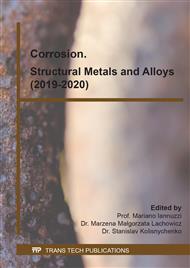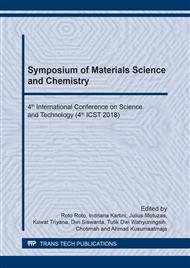[1]
Y.-h. Wei, B.-s. Liu, L.-f. Hou, B.-s. Xu, G. Liu, Characterization and properties of nanocrystalline surface layer in Mg alloy induced by surface mechanical attrition treatment, J. Alloys Comp. 452 (2008) 336-342.
DOI: 10.1016/j.jallcom.2006.11.079
Google Scholar
[2]
H.Q. Sun, Y.-N. Shi, M.-X. Zhang, Wear behavior of AZ91D magnesium alloy with a nanocrystalline surface layer, Surf. Coat. Technol. 202 (2008) 2859-2864.
DOI: 10.1016/j.surfcoat.2007.10.025
Google Scholar
[3]
M. Laleh, F. Kargar, Effect of surface nanocrystallization on the microstructural and corrosion characteristics of AZ91D magnesium alloy, J. Alloys Comp. 509 (2011) 9150-9156.
DOI: 10.1016/j.jallcom.2011.06.094
Google Scholar
[4]
K. Lu and J. Lu, Nanostructured surface layer on metallic materials induced by surface mechanical attrition treatment, Mater. Sci. Eng. A 375-377 (2004) 38-45.
DOI: 10.1016/j.msea.2003.10.261
Google Scholar
[5]
X.H. Chen, J. Lu, L. Lu, K. Lu, Tensile properties of a nanocrystalline 316L austenitic stainless steel, Scr. Mater. 52 (2005) 1039-1044.
DOI: 10.1016/j.scriptamat.2005.01.023
Google Scholar
[6]
B. Arifvianto, Suyitno, M. Mahardika, P. Dewo, P.T. Iswanto, U.A. Salim, Effect of surface mechanical attrition treatment (SMAT) on microhardness, surface roughness and wettability of AISI 316L, Mater. Chem. Phys. 126 (2011) 418-426.
DOI: 10.1016/j.matchemphys.2010.10.038
Google Scholar
[7]
B. Arifvianto, Suyitno, M. Mahardika, Effect of sandblasting and surface mechanical attrition treatment on surface roughness, wettability and microhardness distribution of AISI 316L, Key Eng. Mater. 462-463 (2011) 738-743.
DOI: 10.4028/www.scientific.net/kem.462-463.738
Google Scholar
[8]
B. Arifvianto, Suyitno, M. Mahardika, Effects of surface mechanical attrition treatment (SMAT) on a rough surface of AISI 316L stainless steel, Appl. Surf. Sci. 258 (2012) 4538-4543.
DOI: 10.1016/j.apsusc.2012.01.021
Google Scholar
[9]
N.T. Kirkland, N. Birbilis, M.P. Staiger, Assessing the corrosion of biodegradable magnesium implants: A critical review of current methodologies and their limitations, Acta Biomater. 8 (2012) 925-936.
DOI: 10.1016/j.actbio.2011.11.014
Google Scholar
[10]
T.L. Nguyen, A. Blanquet, M.P. Staiger, G.J. Dias, T.B.F. Woodfield, On the role of surface roughness in the corrosion of pure magnesium in vitro, J. Biomed. Mater. Res. B 100 (2012) 1310-1318.
DOI: 10.1002/jbm.b.32697
Google Scholar
[11]
R. Walter, M.B. Kannan, Influence of surface roughness on the corrosion behaviour of magnesium alloy, Mater. Des. 32 (2011) 2350-2354.
DOI: 10.1016/j.matdes.2010.12.016
Google Scholar
[12]
L. Wen, Y. Wang, Y. Zhou, L.X. Guo, J.H. Ouyang, Iron-rich layer introduced by SMAT and its effect on corrosion resistance and wear behavior of 2024 Al alloy, Mater. Chem. Phys. 126 (2011) 301-309.
DOI: 10.1016/j.matchemphys.2010.11.022
Google Scholar
[13]
A. Pardo, M.C. Merino, A.E. Coy, R. Arrabal, F. Viejo, E. Matykina, Corrosion behaviour of magnesium/aluminium alloys in 3.5 wt.% NaCl, Corr. Sci. 50 (2008) 823-834.
DOI: 10.1016/j.corsci.2007.11.005
Google Scholar



